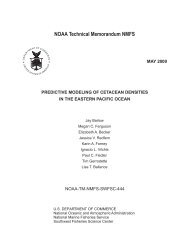NOAA Technical Memorandum NMFS - Southwest Fisheries ...
NOAA Technical Memorandum NMFS - Southwest Fisheries ...
NOAA Technical Memorandum NMFS - Southwest Fisheries ...
You also want an ePaper? Increase the reach of your titles
YUMPU automatically turns print PDFs into web optimized ePapers that Google loves.
acoustic detection distance of sperm whales ranged from 0.7 to 21 nmi, with a mean<br />
acoustic detection distance of 5.9 nmi (SD ± 4.2, Table 5). There were 211 sperm whale<br />
visual and/or acoustic detections within 3 nmi of the trackline; the visual observation<br />
team missed 39% of these sperm whales, while the acoustic detection team missed 8.5%.<br />
C. Towed Hydrophone Array: Minke whales<br />
Minke whales were detected during most surveys, with visual detections<br />
occurring primarily in the temperate study areas and acoustic detections occurring<br />
exclusively in the tropical study areas (Fig. 14). There were a total of 94 minke whale<br />
detections for the combined cruises, of which 85 (90%) were exclusive acoustic<br />
detections (Table 6). The acoustic detection distance of minke whales ranged from 0.5 to<br />
8 nmi, with a mean acoustic detection distance of 3.9 nmi (SD ± 1.7, Table 7). There<br />
were 47 minke whale detections within 3 nmi of the trackline; the visual observation<br />
team missed 80% of these minke whales, and the acoustic detection team missed 19%<br />
(Table 6). None of the minke whales were detected by both the visual and acoustic<br />
teams.<br />
D. Towed Hydrophone Array: Dolphins<br />
There were a total of 1,527 acoustic detections of dolphin schools during the<br />
combined cruises; 779 (51%) were detected by both the acoustic team and the visual<br />
team, and 748 (49%) were exclusive acoustic detections (Table 8, Fig. 15). The<br />
proportion of dolphin schools missed by the acoustic team varied from a low of 7.7% for<br />
the STAR 06 survey, to a high of 29.7% for ORCAWALE (Fig. 15). The proportion of<br />
dolphin schools missed by the visual observation team ranged from a low of 0% for the<br />
SPLASH survey, to a high of 58.5% for HICEAS (Fig. 14). The overall mean acoustic<br />
detection distance for dolphin schools was 3.19 nmi (SD ± 2.0, Table 8). The detection<br />
distances of exclusive acoustic detections were consistently greater than those of<br />
combined visual/acoustic detections (Table 8). The mean acoustic detection distance for<br />
combined visual/acoustic dolphin schools was 2.34 nmi (SD ±1.74), while the mean<br />
acoustic detection distance for acoustic (only) dolphin schools was 4.08 (SD ± 1.98,<br />
Table 8).<br />
All dolphin schools detected exclusively by the acoustics team (49% of acoustic<br />
detections) were considered “unidentified dolphins”, and information on these detections<br />
is limited (Fig. 16, 17). Information collected on visually detected dolphin schools<br />
includes species identity, estimated group size, and general behavioral information. This<br />
information was used to examine the vocal behavior of various dolphin species.<br />
Information on vocal behavior is discussed for each species, in order of decreasing vocal<br />
activity.<br />
Pseudorca crassidens, the false killer whale, was detected only in the tropical<br />
waters of the Pacific Ocean (Fig. 18). There were a total of 19 visual detections of P.<br />
crassidens during the combined surveys, of which 100% produced vocalizations detected<br />
by the acoustics team (Table 9, Fig. 19). The mean acoustic detection distance was 2.93<br />
nmi (SD ± 1.5), with a maximum detection distance of 6 nmi (Table 10). P. crassidens<br />
was found to produce whistles, echolocation clicks, and burst pulses (Fig. 20). All<br />
acoustic detections of P. crassidens included whistles, and 94% of detections included<br />
7









